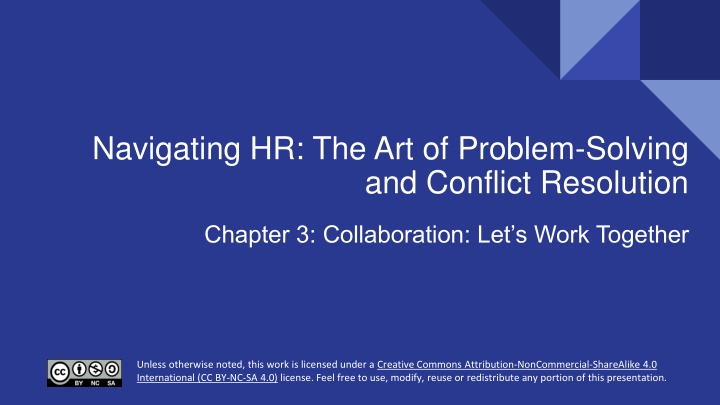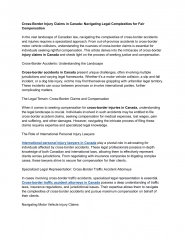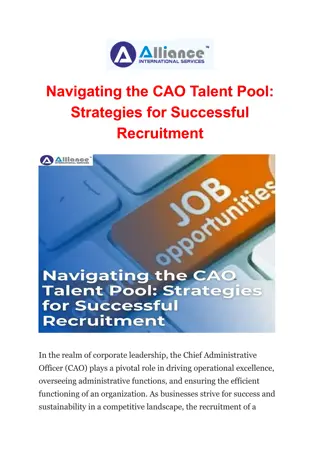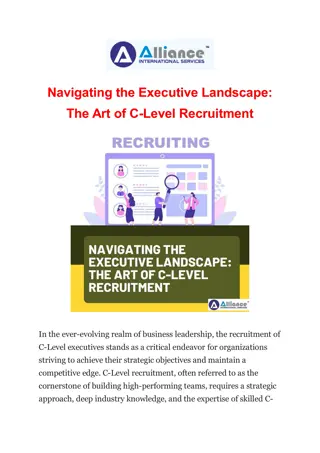
Effective Collaborative Conflict Resolution Strategies in the Workplace
Learn about creating a collaborative environment, establishing ground rules, and the stages of collaborative conflict resolution in the context of HR and problem-solving. Find out how to foster teamwork, active listening, and inclusive discussions to achieve successful conflict resolution in a professional setting.
Uploaded on | 1 Views
Download Presentation

Please find below an Image/Link to download the presentation.
The content on the website is provided AS IS for your information and personal use only. It may not be sold, licensed, or shared on other websites without obtaining consent from the author. If you encounter any issues during the download, it is possible that the publisher has removed the file from their server.
You are allowed to download the files provided on this website for personal or commercial use, subject to the condition that they are used lawfully. All files are the property of their respective owners.
The content on the website is provided AS IS for your information and personal use only. It may not be sold, licensed, or shared on other websites without obtaining consent from the author.
E N D
Presentation Transcript
Navigating HR: The Art of Problem-Solving and Conflict Resolution Chapter 3: Collaboration: Let s Work Together Creative Commons Attribution-NonCommercial-ShareAlike 4.0 International (CC BY-NC-SA 4.0) Creative Commons Attribution-NonCommercial-ShareAlike 4.0 International (CC BY-NC-SA 4.0) Unless otherwise noted, this work is licensed under a Creative Commons Attribution-NonCommercial-ShareAlike 4.0 International (CC BY-NC-SA 4.0) license. Feel free to use, modify, reuse or redistribute any portion of this presentation.
3.0 Learning Objectives In this chapter, we will: Identify the factors necessary to create an environment conducive to collaborative conflict resolution. List the benefits of collaboration or working together. Apply active listening skills to a workplace conflict scenario.
3.2 Creating a Collaborative Environment What does a collaborative workplace look like? What does a collaborative workplace sound like? What does a collaborative workplace feel like? Busy there are employees visibly working together to solve problems Structured you might see meeting rules posted in meeting rooms Organized there is a sense of???? Quiet there are conversations rather than arguments Professional employees greet one another with respect Diversified there is an emphasis on gaining differing opinions Safe employees are free to share their goals and opinions Calm employees don t have to deal with toxic people or conversations Welcoming guests and new employees feel welcomed and included
3.2 Collaboration Establishing the Ground Rules It is common for organizations to establish agreed-upon ground rules. These ground rules guide the meeting and the attendees. Let s look at some common meeting rules. Common Meeting Rules Collaborative Meeting Rules Arrive at the meeting on time No talking over other people Appoint someone to take minutes No working on your electronics during discussions Stay on topic All brainstorming ideas are welcome We encourage active participation by all No shouting or swearing No blaming others Listen with an open mind While these common meeting rules are a great starting place, the list must be expanded when a meeting involves collaborative conflict resolution. These are some guidelines a Human Resources professional might consider adding to the rules.
3.2 The Stages of Collaborative Conflict Resolution Identification: Identify the real source of the issue through discussions and active listening. Understand the goals of the employees involved. Brainstorming: Include individuals in finding solutions, emphasizing teamwork. Generate and discuss ideas without limiting or shutting down suggestions. Implementation: Implement the agreed-upon solution collaboratively. Stages of Collaborative Conflict Resolution by Sanaz Habibi CC BY-NC-SA Assign tasks and timelines, ensuring clarity and written plans. Follow-up: Check if the solution has improved the situation. Revisit and adjust solutions if necessary until all parties are satisfied.
3.2 Collaborative Language Use questions instead of statements to foster collaborative communication during conflict resolution. Statement: It seems like this is important to you. Question: Why is this so important to you? Statement: It is pretty clear what is happening here. Question: Can you tell me what happened from your perspective? Statement: We should focus on the cost to our business. Question: What do you want to focus on? Statement: I know exactly what you mean. Question: Can you tell me what it has been like for you? Statement: I think we should invite others to join us. Question: Do we need to include anyone else in this conversation?
3.3 Spotlight: Active Listening Set Up Ideal Conditions: Manage physical and environmental noises by adjusting location, lighting, temperature, or furniture. Manage Distractions: Avoid listening when distracted by psychological or physiological noise; plan ahead to alleviate these barriers. Prime Yourself: Analyze the situation and set listening goals before it begins. Maintain Focus: Find motivation to listen by considering how the message impacts your life, career, or relationships. Overcome Selective Attention: Identify motivations to help remember the information presented. Clarify Messages: As senders, help listeners by offering well- organized and clear messages tailored to the audience.
3.3 Active Listening Behaviours Active Listening Preparation: Use cognitive strategies to enhance listening and engage in active listening behaviors while processing messages. Paying Attention: Eye contact and body language signal attentiveness, but lack of eye contact can indicate cognitive processing. Back-Channel Cues: Use head nods and verbal cues like "uh-huh" to show attention, but avoid pseudo-listening. Probing Questions: Ask questions to indicate listening and encourage further conversation, seeking both clarification and elaboration. Avoid Interruptions: Stay engaged without interrupting, especially when interacting with high-status individuals. Note-Taking: Taking notes can help interpret and recall information, though it may not always be appropriate in casual settings.
3.3 Active Listening and Conflict Conflict and Listening: Stress from conflict makes active listening challenging, often leading to missed key information. Inattentional Blindness: In conflict, focusing on your own points can cause you to miss significant verbal and nonverbal cues. Speech vs. Thought Rate: You process information faster than it can be spoken, which can hinder true listening during conflicts. Recognize Distractions: Acknowledge that distractions are natural and you will likely miss something important. Avoid Distractions: Maximize attention by eliminating distractions, such as turning off your phone. Pause and Reflect: Don t hesitate to slow down conversations to ensure you are actively listening, which helps build stronger relationships.
3.3 Paraphrasing Paraphrasing: Paraphrasing involves repeating something using different words to make the original meaning clearer. Different Words: Using different words shows true understanding and is not the same as parroting. Check for Understanding: Paraphrasing helps ensure you have accurately understood the original message. Scenario: The original statement made by the employee: I know that Maurice is taking reams of paper, boxes of pens, and ink cartridges home with him every day, and he is bragging to people about making so much money off these supplies. Your paraphrased statement as the Human Resources Coordinator: To clarify, you have observed Maurice stealing office supplies from our company and are suggesting he is selling them for profit. Is that correct?
3.6 Key Takeaways Collaboration, or working together, is an effective approach to conflict resolution regardless of the scenario Human Resources professionals should utilize active listening skills when meeting with employees in order to demonstrate a sincere interest in the matter When paraphrasing, you are to summarize what you have heard to check for understanding It is important to create an environment that is conducive to collaborative conflict resolution Collaborative conflict resolution involves identifying the issue, brainstorming solutions, implementing an agreed-upon solution, and following up to ensure the matter has been addressed.


















